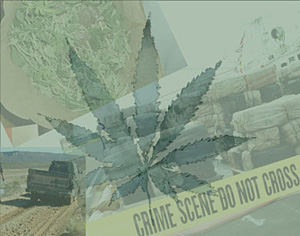 |
 |
 |
 Editorials | May 2007 Editorials | May 2007  
Drugs Fuel Crime Wave in Mexico
 sharedresponsibility.gov.co sharedresponsibility.gov.co


| | According to Mexico’s Attorney General, Eduardo Medina Mora, the crime wave is in part due decreasing demand for cocaine in the United States, driving Mexican cartels to fight over diminishing profits. (Lisa Cumbie) |
Last year, 2,000 Mexicans were murdered by drug-related violence, but with 1,000 murders so far this year, 2007 may prove to be even deadlier.

On May 11, one day after Mexican President Felipe Calderón announced that anti-narcotic forces in the port city of Veracruz would receive reinforcements, a decapitated head and two grenades, placed inside a box, were launched at one of the city’s military stations. President Calderon’s decision to send reinforcements immediately answers to last week’s killing of four Veracruz policemen, in charge of protecting a senior politician, by a local drug gang.

However, the reinforcements are part of a larger plan to stem increasing drug violence throughout the country, particularly in the coastal departments of Sinaloa and Michoacán. And this plan answers to the death of somewhere near 1,000 Mexicans, among these journalists, police officers and innocent civilians, most of whom are victims of a battle between the nation’s two main drug cartels to control the main drug routes into the U.S.

According to Mexico’s Attorney General, Eduardo Medina Mora, the crime wave is in part due decreasing demand for cocaine in the United States, driving Mexican cartels to fight over diminishing profits. Medina Mora also attributes the recently reported drop in cocaine prices in the U.S. to this decreased demand, which prompted drug traffickers to seek new customers. The most buoyant market for cocaine is now found in Europe, with an alarming increase in consumption also taking place in México and Brazil, signaled the Attorney General.

The cartels in question are the Cartel of Sinaloa, a narrow Mexican department along the Pacific Ocean, and the Gulf Cartel, based along the Gulf of Mexico. In an article published last week, Reuters posits that the extradition of Gulf Cartel leader Oriel Cardenas to the U.S. weakened this cartel and incited the Sinaloa Cartel to expand into Gulf Cartel territory. Defending its territory, the Gulf Cartel retaliated by opening a new front in the Pacific states of Guerrero, Michoacán and Jalisco.

Tourism trapped

Guerrero is perhaps most well known for its capital city – Acapulco, one of the nation’s premier tourist destinations. But, reports of increasing violence have begun to affect the city’s international appeal. The Houston Chronicle estimates that of the 2,000 drug-fueled murders that took place last year, 300 occurred in Guerrero.

Furthermore, decapitated heads, apparently a popular calling card among Mexico’s drug cartels, were placed outside of Acapulco’s government offices last summer. One even appeared on a public beach. But, it was the murder of a prominent local journalist this past April 6th that caused the U.S. State Department to update its travel warning to Mexico, which for the first time warns of the Acapulco’s drug-related violence:

“Narcotics-Related Violence - U.S. citizens residing and traveling in Mexico should exercise caution when in unfamiliar areas and be aware of their surroundings at all times. Violence by criminal elements affects many parts of the country, urban and rural, including border areas. In recent months there have been execution-style murders of Mexican officials in Tamaulipas (particularly Nuevo Laredo), Michoacan, Baja California, Guerrero (particularly Acapulco), Nuevo Leon (especially in and around Monterrey) and other states.”

Hard pressed

The murdered journalist was Amado Ramírez, 50, who hosted a radio show Monday through Friday that received calls from citizens with complaints, often regarding corrupt officials and drug gangs. On the same night that Ramírez was gunned down, a guard who worked at the radio station received a message stating: “We are not finished. One down. Misa is next.” ‘Misa’ is the nickname to which Misael Habana, Ramírez’ co-host, asnwers.

Last year, Mexico overtook Colombia in the ranking of deadliest countries for journalists, moving into second place behind Iraq. The Inter-American Press Association reported 7 journalists gunned down last year, Reporters without Borders has a count of 9 and the Mexican Federation of Press Associations signaled 11.

“Before, when we sent in an article, our editors would say ‘Good luck!’ Now they say, ‘Be careful,’” said Eduardo Laredo, another Acapulco radio host, in an interview with the Houston Chronicle. Laredo and others participated in a march on May 3rd, International Press Freedom Day, rallying for justice in the case of Ramírez’ murder.

But, this same day, back in Veracruz, another head rolled. The decapitated head of a local drug trafficker was dropped outside of the offices of one of the city’s daily papers. The messenger, although savagely silenced, delivered his message loud and clear.

Shared Responsibility is a Colombia-led initiative for illicit-drug producing and consuming countries to work on shared solutions to the threat that cocaine production, trafficking and abuse poses to the world. | 
 | |
 |



